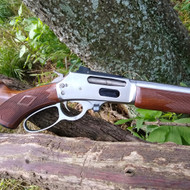Mid Bore Lever Action Rifle Ballistics: .38-55, .375, .30-30
Posted by Adam Devine on Apr 21st 2022
Welcome to Part II of our Lever Gun Ballistics series. We’re going to have a look at the “Thirty Somethings” today, including the straight wall .38-55, the .375 Winchesters, the .35 Remington, and the GOAT, the .30-30 Winchester.
If the .30-30 Winchester is not the Greatest Of All Time, it at least deserves to be on the podium with Tom Brady. Its gently tapered shoulder and long neck make it look like Grandpa in plaid polyester, but that just goes to show you that being great at your job is always fashionable. Over the years, there have been numerous attempts to “improve” the ol’ dirty 30 and even a couple of coup attempts, but the old woodsman just shrugs them off and keeps putting meat in the freezer, same as always. Legend has it that the .30-30 has bagged more deer than any other cartridge. So what if Brady has won a few Super Bowls?
Today, there is a generous variety of factory .30-30 loadings, appropriate to a wide range of game, from varmints to pigs to predators. Short barreled rifles so chambered make excellent self defense weapons for home and ranch. Modern bullets and powder recipes have stretched the cartridge’s range and performance, but recoil remains tame, making it a first choice for hunters teaching their kids the sport. The legend lives on. It would not be unwarranted to insist that no respectable rifle collection is complete without a .30-30 lever action.
Launched with Remington’s Model 8 autoloader over a century ago, the .35 Remington has the distinction of being the only common lever gun cartridge that is rimless. Its performance is a bit hobbled by the low pressure Remington specified for its autoloader, but despite this, the heavier .35 caliber bullets penetrate reliably on tougher game like hogs and black bear, and the cartridge has retained a cult following.
Hand loaders have always enjoyed saucing up the .35, but a couple of decades ago, Hornady brought factory loads a boost with its LeveRevolution line of ammunition, successfully pushing the cartridge beyond the “brush gun” category and into rangier settings. Now, the resurgence in lever gun popularity has brought new factory offerings to all chambers, including the .35 Rem. Owners can enjoy moderate recoil, reasonable (ahem) ammo prices, and reliable performance on the hunt, or in outdoor self defense scenarios.
The .375 and .38-55 Winchesters are an odd couple. The hyphenated round has been around nearly as long as the .45-70 Govt. and can be thought of as the Govt’s little brother. Unlike the .45-70, which gradually evolved into two different load types (original and extra spicy), the .38-55 stopped evolving after the switch to smokeless powder. It might have fallen by the wayside entirely if the cowboy action set had not scooped it up. It remains popular enough that Henry chambers rifles for it to this day.
The .375 is the .38-55’s snappy, modern progeny, a closer cousin to the .444 Marlin than the old .45-70. The .375 is an impressive performer that never quite took off, and today you have to dig through old Marlins and Winchesters to find a rifle so chambered.
Both mid bores are good for hunting deer, hogs and black bear, with the .375 offering more range and assurance on the tougher animals. In competition, the .38-55 is often used past 300 yards, but most hunters would limit their shots to around 100yds. The chubby bullets fall off quickly. Both cartridges have potential as self defense rounds, but a dearth of bullet choices and factory ammo limit their usefulness in this regard.
It can be said of all lever gun cartridges that accuracy is often more a function of the rifle than the ammo. Tube fed lever actions especially have hurdles to overcome, with so much junk hanging from their barrels, and yet, very often they clear those hurdles with flying colors, delivering fine hunting accuracy. With a bit of careful tuning they can often shoot hole for hole with a good bolt action.
The usual rules apply of course, some ammo is better than others, and some rifles have strong preferences in ammo. Longer, sleeker bullets will generally be easier to shoot well over distance than short, chubby bullets, and long-ish barrels will retain more useful velocity for field work. But if your lever gun doesn’t deliver satisfactory accuracy, don’t be too quick to blame the ammo, or the cartridge choice. Stick with the chambering that makes sense for your intended use, and seek expert advice in tuning for the accuracy you need. The links below are a good place to dive into that rabbit hole. We’ll see you in Part III.
Accurizing the Marlin Lever Action Rifle
The Road to Marlin Lever-action Accuracy and Performance: Twisties and all
Frequently Asked Questions
What is a .35 Rem rifle good for?
A 35 Rem is most commonly used in lever-action and bolt-action rifles for hunting deer and other medium-sized games. It has good stopping power and manageable recoil making it a good choice for novice hunters. Some people also use it for target shooting.
What is the difference between a .30-30 Win and a .35 Remington?
The primary difference between the two cartridges is their power and range. The .30-30 has more stopping power and can travel further than the .35 Remington. However, the .35 Remington has less recoil than the .30-30, making it easier to shoot accurately.
How powerful is a .35 Remington?
The .35 Remington is a very effective caliber for hunting. It packs a lot of punch and is capable of taking down large game animals. The ballistics are impressive, and it has a good reputation for being accurate and powerful. It's a great choice for hunters who want a serious firearm parts that can handle anything they might encounter in the field.

